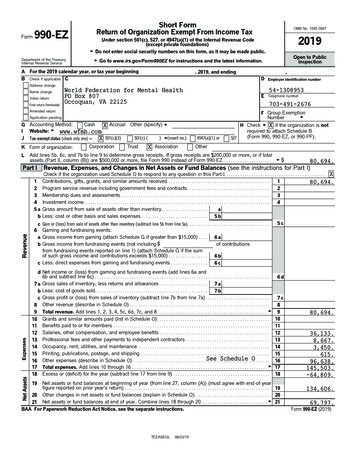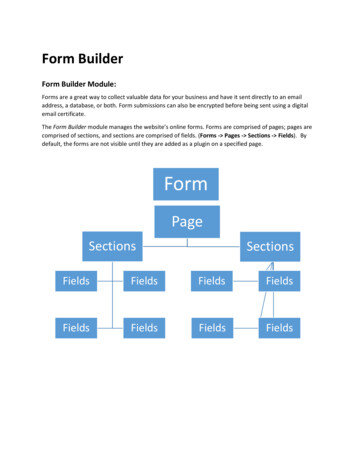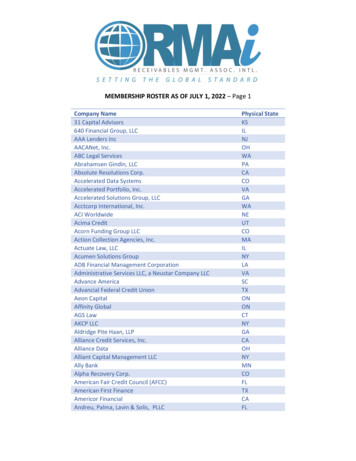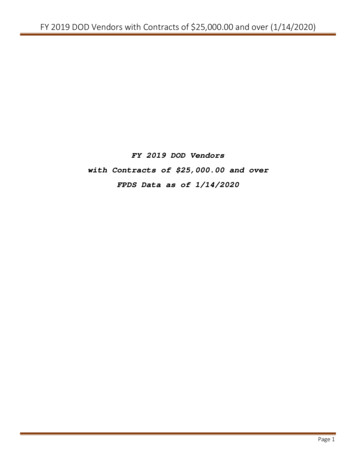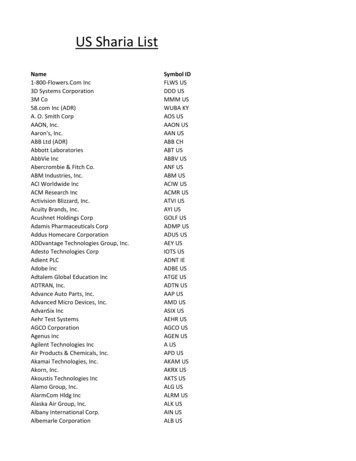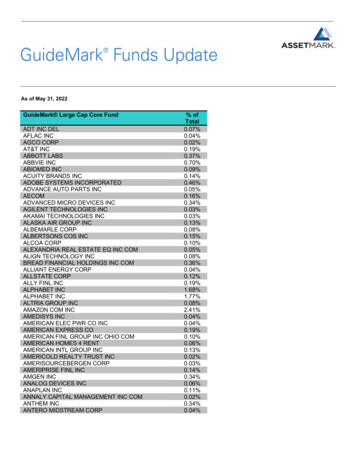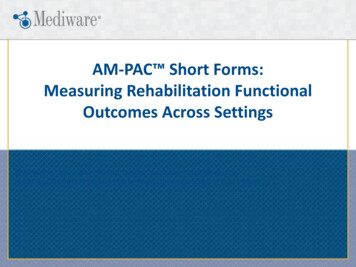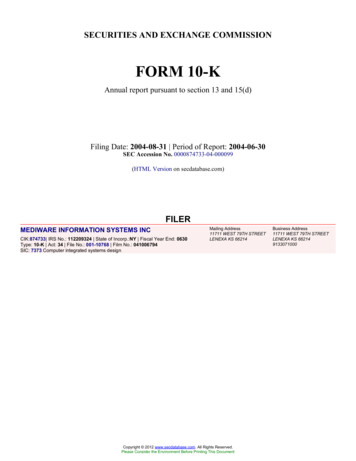
Transcription
SECURITIES AND EXCHANGE COMMISSIONFORM 10-KAnnual report pursuant to section 13 and 15(d)Filing Date: 2004-08-31 Period of Report: 2004-06-30SEC Accession No. 0000874733-04-000099(HTML Version on secdatabase.com)FILERMEDIWARE INFORMATION SYSTEMS INCCIK:874733 IRS No.: 112209324 State of Incorp.:NY Fiscal Year End: 0630Type: 10-K Act: 34 File No.: 001-10768 Film No.: 041006794SIC: 7373 Computer integrated systems designMailing Address11711 WEST 79TH STREETLENEXA KS 66214Copyright 2012 www.secdatabase.com. All Rights Reserved.Please Consider the Environment Before Printing This DocumentBusiness Address11711 WEST 79TH STREETLENEXA KS 662149133071000
UNITED STATESSECURITIES AND EXCHANGE COMMISSIONWashington, D.C. 20549FORM 10-K(Mark One)[X] ANNUAL REPORT PURSUANT TO SECTION 13 OR 15(d) OF THE SECURITIES EXCHANGE ACT OF 1934For the fiscal year ended June 30, 2004OR[ ] TRANSITION REPORT PURSUANT TO SECTION 13 OR 15(d) OF THE SECURITIES EXCHANGE ACT OF 1934For the transition period from toCommission file number: 1-10768MEDIWARE INFORMATION SYSTEMS, INC.(Exact name of registrant as specified in its charter)New York11-2209324(State or other jurisdiction ofincorporation or organization)(I.R.S. Employer Identification No.)11711 West 79th StreetLenexa, KS66214(Address of principal executive offices)(Zip Code)Registrant's telephone number, including area code:(913) 307-1000Securities registered pursuant to Section 12(b) of the Act: NoneCopyright 2012 www.secdatabase.com. All Rights Reserved.Please Consider the Environment Before Printing This Document
Securities registered pursuant to section 12(g) of the Act:Title of each className of each exchange on which registeredCommon Stock, par value .10 pershareNASDAQ Small Cap MarketThe Pacific Stock ExchangeIndicate by check mark whether the registrant (1) has filed all reports required to be filed by Section 13 or 15(d) of the Securities Exchange Act of 1934 duringthe preceding 12 months (or for such shorter period that the registrant was required to file such reports), and (2) has been subject to filing requirements for thepast 90 days. [X] Yes [ ] NoIndicate by check mark if disclosure of delinquent filers pursuant to Item 405 of Registration S-K is not contained herein, and will not be contained, to the bestof registrant's knowledge, in definitive proxy or information statements incorporated by reference in Part III of this Form 10-K or any amendment to this Form10-K. [ ]Indicate by check mark whether the registrant is an accelerated filer (as defined in Rule 12b-2 of the Act).[ ] Yes [X] NoThe aggregate market value of the voting stock held by non-affiliates of the registrant, based upon the closing sales price of its common stock on December 31,2003 as reported on the NASDAQ Small Cap Market, was approximately 82,474,000. The number of shares outstanding of the registrant's common stock, asof August 26, 2004, was 7,704,000 shares.DOCUMENTS INCORPORATED BY REFERENCEThe information required for Part III of this Annual Report on Form 10-K is incorporated by reference from the Registrant's ProxyStatement for its 2004 Annual Meeting of Shareholders, to be filed with the Securities and Exchange Commission within 120 daysafter the end of the Registrant's fiscal year.PART IThis report contains forward-looking statements. For this purpose, any statements contained herein that are not statements ofhistorical fact may be deemed to be forward-looking statements. Without limiting the forgoing, the words "believes," "anticipates,""plans," "seeks," "expects," "intends" and similar expressions are intended to identify forward-looking statements. The importantfactors discussed below under the caption "Factors That May Affect Future Results," among others, could cause actual results todiffer materially from those indicated by forward-looking statements made herein and presented elsewhere by management fromtime to time. The Registrant undertakes no obligation to publicly update or revise any forward-looking statements, whether as aresult of new information, future events or otherwise.Item 1. Business.OverviewMediware Information Systems, Inc. and its subsidiaries ("Mediware" or the "Company") develop, implement and support clinicalmanagement information systems marketed to the healthcare industry. The Company's systems are designed to automate threeclinical departments within the hospital environment: the blood bank, the pharmacy and the surgical suite, along with stand-aloneCopyright 2012 www.secdatabase.com. All Rights Reserved.Please Consider the Environment Before Printing This Document
blood centers. A system typically consists of the Company's proprietary application software, third-party licensed software and thirdparty computer hardware, as well as implementation services, training, and annual software support. The business is organized intothree operating divisions marketing three distinct product lines: Pharmacy Systems, Blood Bank Systems and Operating RoomSystems. The Blood Bank and Operating Room Divisions operate primarily in the United States. The Pharmacy Division operatesboth in the United States and in the United Kingdom.The Company's systems are installed in over 1,100 hospital departments and blood centers including some of the industry's mostprestigious institutions. The Company's products are designed to improve the availability of clinical information while enablinghealth care facilities to decrease the expenses associated with managing the clinical departments. These benefits are of criticalimportance to clinical administrators who face increasing financial and regulatory pressures. The Company believes that it has thelargest number of systems installed in the "best of breed" pharmacy and blood bank systems markets, and that these products havegained their leadership position because of rich functionality, ease of integration and excellent customer service. These corecompetencies have influenced some of the most prestigious health care facilities in North America to purchase the Company'ssystems.Mediware is a New York corporation incorporated in 1970. The Company's cornerstone product, Hemocareâ , was originallydesigned in 1981 and is one of North America's leading blood bank information systems in the markets it serves, either as a "standalone" system or as part of an integrated "Lab/Blood Bank" system.In May 1990 the Company acquired Digimedics Corporation ("Digimedics"), one of the country's leading vendors of informationmanagement systems for hospital pharmacies. Digimedics introduced the first open systems version of a comprehensive pharmacyinformation management system in the mid-1980s. In June 1996 Digimedics expanded its operations with the acquisition of certainassets of Information Handling Services Group, including the U.S.-based Pharmakon Division and the U.K.-based JAC ComputerServices, Ltd. The Pharmakon operations were subsequently merged with the Digimedics operations to form the Pharmacy Divisionof the Company.The Operating Room Division, formed in April 1998, grew from the expansion of its SurgiwareTM product center. The Surgiwaresystem, licensed in September 1990 from Intellimed Incorporated, was marketed through fiscal 1999. In fiscal 1999, the Companyintroduced a new operating room product, Perioperative Case Management for Windows ("PCMWinä "), which was renamedPerioperative Solutionsä in fiscal 2002. Perioperative Solutions is an n-tiered Microsoft Windows 2000-based client serverapplication that provides the full functionality necessary to manage an operating room and associated departments.In September 1998 the Company acquired Informedics, Inc., which develops and markets a line of computer software applicationsdesigned for hospital blood bank and blood centers.In November 1999 the Company expanded its Blood Bank Division with the acquisition of LifeTrakâ from Carter BloodCare("Carter"). LifeTrak is a comprehensive system for managing donor, laboratory and distribution for the blood center.In July 2001 the Company entered into an intellectual property agreement with Ortho Clinical Diagnostics, Inc. ("Ortho"), whichallowed the Company to market an integrated testing module that wasdeveloped as part of the LifeTrak product but held on an exclusive basis by Ortho until 2003. On January 1, 2003, Carter transferredtitle of the integrated testing module to the Company on a non-exclusive basis.In February 2003, the Company received 510(k) clearance from the Food and Drug Administration ("FDA") on its next generationtransfusion management system HCLLä . The Company is now actively introducing HCLL to its current customers and newcustomers and expects that customers will benefit from the state-of-the-art functionality offered by HCLL. In April 2004, theCompany received additional 510(k) clearance from the FDA for additional enhancements to the HCLL product.The Company's Corporate Transaction StrategyIn order to broaden product offerings, capture market share, improve profitability and capitalize on the consolidation trend in thehospital clinical information system industry, the Company's business strategy includes growth through acquisitions and othercorporate transactions. The Company reviews and considers corporate transaction possibilities on an ongoing basis, but there can beCopyright 2012 www.secdatabase.com. All Rights Reserved.Please Consider the Environment Before Printing This Document
no assurance that the Company will be able to identify or reach mutually agreeable terms with any transaction candidate.The Company also seeks (but cannot provide assurance that it will be able) to develop strategic partnerships that are complimentaryto its core markets and product set, mutually beneficial to both parties and that provide a greater value proposition to the customerthan could be realized without the strategic relationship.The Healthcare Information Systems IndustryThe healthcare delivery industry in the United States is highly fragmented, complex, and inefficient. Advances in medicaltechnology directly dealing with human disease and injury have resulted in significant breakthroughs and progress. Physicians,nurses and other caregivers are given leading edge diagnostic and therapeutic technologies. However, the information systemssupporting the management and clinical processes of these complex healthcare organizations have made insufficient progress. Asubstantial portion of clinical workflow still depends upon manual paper-based systems interfaced with various automated systems.Historically, the healthcare industry has invested relatively less in information technology than some other industries.As a result of the above, this industry is economically inefficient and produces significant variances in medical outcomes. InFebruary 2001, the FDA published a report entitled "Doing What Counts for Patient Safety; Federal Actions to Reduce MedicalErrors and Their Impact." This report enumerated the high level of human error in healthcare and underscored the potential taintingof the U.S. blood supply. In November of 1999 the Institute of Medicine released a report called "To Err Is Human: Building a SaferHealth System," indicating that medical error is one of the top ten causes of death in the United States. This report indicated that upto 96,000 lives may be lost each year as a result of medical error. Mediware believes it can play an important role in addressing theseissues, with its clinically focused management information systems. The Company's products are designed to help improveefficiencies, reduce error and improve quality of care.In 1996, Congress passed legislation that impacted healthcare information management. The Healthcare Information Portability andAccountability Act ("HIPAA") required the Department of Health and Human Services ("HHS") to enact standards for informationsharing, security and patient confidentiality. The Company believes these regulations are having an important impact on the healthcare industry and are encouraging healthcare organizations to consider new advanced management information systems that addressthe needs of HIPAA and other state regulations.The Company believes the healthcare industry has significantly under-invested in information technology. However, the Companyanticipates that with the continued increase in government regulation and concern over clinical outcomes, the healthcare industry'sexpenditures on clinical information systems will increase as they modernize and update their clinical information systems. In fact,the Leapfrog Group, a consortium of large employers that spends 40 billion annually on healthcare, has called for investment intocomputerized information systems. Recently, President George W. Bush pledged financial support for increased healthcare ITstandards and incentives to make IT investments for hospitals more appealing. He also announced his support for a national health ITcoordinator who would report directly to the Secretary of Health and Human Services, Mr. Tommy Thompson. Mediware believesthat its products will play a significant role in moving healthcare IT standards forward.The Company believes that in addition to healthcare industry evolution and the impact of regulatory developments, which will drivethe need for improved management information systems, specific potential health threats such as the variant Creutzfeldt-Jakob (madcow) virus and patient medication safety will require organizations to re-examine their ability to track and analyze patients, donors,procedures and outcomes. Mediware's "best of breed" solutions, which integrate operating and clinical systems, are targeted tosubstantially facilitate solutions to these healthcare industry issues.Competition in the market for clinical information systems is intense. The principal competitive factors are the functionality of thesystem, its design and capabilities, site references, reputation for ongoing support, the potential for enhancements, price, best-ofbreed vs. enterprise sales and salesmanship. Also key is the strategic position the incumbent, or major healthcare informationsystems vendor, has in the customer site. Different dynamics and competitors, however, affect each of the Company's products.These factors are discussed in the following analysis of each respective product line.Copyright 2012 www.secdatabase.com. All Rights Reserved.Please Consider the Environment Before Printing This Document
Blood Bank DivisionThe Blood Bank Division is a supplier of information and management systems to blood donor and transfusion centers. During fiscal2004, the Company received an updated 510(k) clearance from the FDA on its next generation blood transfusion product - HCLL.Management started marketing HCLL to new and existing customers, with the first shipment in June 2003. Earlier this year, the firstsites have "gone live" with HCLL. HCLL is a windows-based, n-tier client server clinical transfusion medical system, which isdesigned to provide the transfusion marketplace with state of the art technology. This system is designed to be user intuitive,scalable, and supports product management, resource management, quality control and testing. This system includes advanced datamining and data management intelligence capabilities, which can be utilized by small hospitals, large medical centers, multi-facilityenterprises and central transfusion services.In late 1999 the Division acquired the LifeTrak product from Carter. LifeTrak provides blood collection and processing centers withan application designed to serve their particular needs, from donor recruitment through testing to inventory control. LifeTrak canoperate on both the Linux and Unix operating systems. These operating systems allow the customer donor site to configure hardwareaccording to its needs and budgetary constraints. The Unix-based LifeTrak system is more suitable for larger customer donor sites,while the Linux-based system is more cost effective for smaller hospital donor centers.In July 2001 the Company entered into an intellectual property agreement with Ortho, which allows the Company to market anintegrated testing module that was developed as part of the LifeTrak product, but held on an exclusive basis by Ortho until 2003. OnJanuary 1, 2003, Carter transferred title of the integrated testing module to the Company on a non-exclusive basis.In the spring of 2004, the Division initiated the process of migrating the users of its two heritage products, Hemocareâ andLifeLineä , which were originally installed in the 1980s, to Mediware's new HCLL product. The two heritage products have a largeinstalled base within the transfusion management market and represent an important opportunity for new sales for the Division. TheCompany will closely coordinate with these users to support their migration to HCLL. Management anticipates, but cannot assure,that the new product will be accepted by the heritage product users.The Company's blood bank systems business expects to benefit from stem cell initiatives both in the private and public sectors. TheCompany believes it is positioned to expand its product offerings into the broader market of biologic products, for example bone andtissue related software solutions. Additionally, these products may help minimize or avert a prolonged shortage of biologic productsincluding donor blood and blood components, and to help ensure the current high level of safety.The safety of the nation's blood supply remains of utmost importance, requiring improved screening and the ability to substantiallyreduce errors as hospitals and blood centers adopt systems allowing for increased throughput and cost efficiencies. Pressurescontinue to reduce costs in all areas of healthcare, including blood-banking services. At the same time, shortages of laboratorypersonnel in key functions are occurring across the country, prompting U.S. legislative proposals for incentives to recruit and trainmore qualified people.Mediware's user-friendly blood bank systems software is intended to address these issues. This software is designed to reduce coststhrough automatic report production, decreased paperwork, and automated billing. The Company's products can improve bloodsupply safety and the productivity of blood center personnel through the use of user-defined truth tables and automatic linking todonors' historical records, among other features. Donor recruitment programs are enhanced though LifeTrak donor software bymaking tele-recruiters more productive.Mediware competes primarily with vendors of laboratory information systems ("LIS") providing a blood bank subsystem as a part oftheir laboratory product, as well as other companies that market stand-alone blood bank systems. The LIS vendors are much largercompanies with greater technical, marketing, financial and other resources than the Company. The Company believes that the 510(k)clearance process is sufficiently onerous to discourage many potential new entrants into this market segment.The Company is continuing to explore the expansion of its e-commerce solution to integrate the flow of information from the supplyof blood facilities to the transfusion of blood. The Company's plans include the expansion of its Application Service Provider("ASP") Model which assisted with the testing of over 2.7 million units of blood during 2004. In an ASP Model, clinicalmanagement applications and data are processed at a central location and distributed along with local expert services to customersvia a secure connection. The ASP Model has the advantage of reducing distribution and support costs along with increasing thepotential of improved supply chain management over the distribution and use of blood products. The Company's current plan is toinclude expert services such as regulatory advice as part of its ASP offerings.Copyright 2012 www.secdatabase.com. All Rights Reserved.Please Consider the Environment Before Printing This Document
In addition to the initial sale of the Company's blood bank systems, revenues are generated from post-contract support, averagingapproximately 21% annually of the system's original selling price. These maintenance contracts currently account for over 50% ofthis Division's revenues and are recurring in nature. As customers transition from the Division's heritage products to HCLL,management believes that systems revenues will represent more than 50% of the Division's total revenue.The Blood Bank Division markets its products primarily through a direct sales force consisting of a National Sales Director, fiveRegional Sales Representatives and four Clinical Consultants who perform on-site demonstrations of the products. Additionally, theCompany is in the process of developing reseller relationships for certain of its ancillary products. The Blood Bank Division willcontinuously review (and adjust as appropriate) its distribution model as new products and services obtain 510(k) clearance.The Company believes that it has an excellent service reputation with over 500 healthcare organizations that are Blood BankDivision customers, many of which have multiple facilities. Mediware anticipates that its installed Blood Bank customer base willprovide an excellent market for its new products.Pharmacy DivisionIn May 1990 the Company acquired Digimedics, one of the country's leading vendors of information systems for hospitalpharmacies. The Digimedics pharmacy information system, based on the UNIX operating system, the "C" programming languageand the Unify relational database management system, was a leading competitor in the market. In June 1996, the Company acquiredcertain assets of the Pharmakon (U.S.-based) and JAC (U.K.-based) Divisions of Information Handling Services Group. Pharmakon,which was available on a variety of minicomputer and mainframe hardware platforms, was also a leading competitive offering in thepharmacy systems market. The Company believes that it has a strong customer service reputation with the installed base of hospitalsthat are Pharmacy Division customers.In November 1997 the Pharmacy Division introduced the WORxâ drug therapy management system. This system is an n-tiered,object oriented Windows-based client/server pharmacy system. As a result of its Windows user interface, advanced underlyingsystems integration architecture and user-friendly design, WORx is positioned to be the hub for drug therapy management. Thisincludes integration with automated drug dispensing cabinets manufactured by Pyxis Inc., a Division of Cardinal Health, Inc., andOmnicell Technologies, Inc. and interfaces to other pharmacy dispensing devices such as the AHI RxOBOT produced by a Divisionof McKesson HBOC, Inc. WORx Universal, released in June 1999, provides access to clinical data via the Internet/intranet using astandard web browser on multiple platforms, including hand-held and wireless devices.Since its introduction, WORx has been sold to over 125 hospital organizations encompassing over 250 hospital sites. The product'smarket acceptance encompasses hospitals of all sizes, including strategically important multi-site hospitals. The Pharmacy Divisionhas developed features and functions designed to help improve patient safety and manage pharmacy operations effectively. TheCompany has implemented a bi-directional orders interface between WORx and major Health Information Systems ("HIS") vendors.This interface allows WORx to populate the HIS systems with complete, accurate, and up-to-the-minute patient medication profiles.In addition, this interface allows pharmacists to effectively manage medication orders input into third party systems by nurses andother healthcare professionals. This interface provides a valuable utility for assuring medication orders are interpreted and dispensedcorrectly.Other important developments include a sophisticated inventory management module, designed to assist pharmacy managers in theireffort to control drug therapy costs and an ambulatory care module that is fully integrated with the WORx inpatient modules. Theinventory management module has been designed to meet the challenges of inventory control, purchasing, receiving, and contractadministration in a hospital setting. The inventory management module uses bar code and Electronic Data Interchange technologiesto simplify processes.The product focus of the Pharmacy Division is strengthening the Company's market share position and ensuring patient safety. ThePharmacy Division recently released two new products, MediCOETM and MediMARTM. These products are fully integrated withWORx and provide a complete drug therapy management system with a physician order entry module (MediCOE) and nurse point ofcare administration module (MediMAR). MediMAR provides wireless point of care medication administration transactionprocessing to insure the five rights of patient safety. In addition, the product provides other clinical features to nursing including painmanagement and nursing documentation. MediCOE enables physicians or other appropriate clinicians to enter medication ordersCopyright 2012 www.secdatabase.com. All Rights Reserved.Please Consider the Environment Before Printing This Document
using a remote PC, a handheld wireless device or offsite via web-based connectivity. The orders are integrated with the patient'smedical profile which includes laboratory, prescription and allergy information. MediCOE alerts physicians to any adverse effectthat may occur due to the patient's medical history, thus making a significant contribution to patient safety. Both MediCOE andMediMAR are targeted for the Company's installed Pharmacy customer base and are expected to attract new customers as well.The Pharmacy Division markets directly through a sales force which consists of a National Sales Manager, five Regional SalesRepresentatives covering territories in the United States and Canada and one Sales Representative who sells into our existingcustomer base. Two Clinical Consultants with extensive experience as clinical pharmacists and pharmacy technicians providetechnical sales support. Other marketing channels utilized by the Pharmacy Division include reseller agreements with a number ofdistribution partners.Operating Room DivisionIn September 1990 the Company licensed the Surgiware system from Intellimed Incorporated for use in surgical suites. Surgiware, acomprehensive information system for managing the human resources, facilities, equipment and supplies required for surgery, wasreplaced as the Company's primary Operating Room software in fiscal 1999 by PCMWin.In fiscal year 1999, the Company introduced PCMWin. PCMWin's name was changed in 2002 to Perioperative Solutions, reflectingits broadening scope of functionality for the entire perioperative department. Perioperative Solutions is based on an n-tieredMicrosoft Windows-based client server application that provides the full functionality necessary to manage an operating room and itsassociated departments while supporting and documenting the entire perioperative clinical event, providing information that iscrucial for compliance with insurance and regulatory reporting, and identifying potential conflicts and opportunities for improvementthroughout the entire process.Perioperative Solutions includes Scheduling, Case Preference Management, Credentialing, Inventory Management, PerioperativeCharting, Status Board, Reporting, PS Trackerä for executive and operational analysis, PS Clinical Intelligenceä to automate themaintenance of preference cards, PS Bar Code Scanning, and HL7 standard interfaces. The benefits of a fully implemented systeminclude:-- Increased utilization rate of operating rooms;-- Increased productivity from efficient management of staff and equipment;-- Improvement in inventory management;-- Increased patient billings as a result of real time capture of information; and-- Increased management intelligence through data mining.Development activities are focused upon adding features and functions along with the addition of new modules. Functionality tosupport customers with multiple hospitals or surgical centers has recently been added with enhancements scheduled for upcomingreleases. The Pre-Assessment module will manage all of the activity that is necessary prior to the patient arriving in the operatingroom. This includes documenting clinical assessments and pre-admission testing. PS Tracker and PS Clinical Intelligence wereupgraded during fiscal 2004 and will continue to be expanded in scope. PS Tracker is a powerful and user-friendly data analysis tool,which has been designed so that operating room management, physicians, and hospital administrators can effectively gainmanagerial intelligence through data mining of the comprehensive database created by Perioperative Solutions. PS ClinicalIntelligence addresses one of the most pressing issues with operating room information systems, keeping the thousands of surgeonspecific preferences up to date. It automates this process, improving accuracy while saving time. The Company filed for and receiveda patent on its PS Clinical Intelligence technology in January 2003.The Operating Room Division markets on a direct sales basis utilizing one direct Sales Representative. It is also pursuing severalstrategic reseller arrangements.JACThe Company's United Kingdom operating division originated with the acquisition of JAC Computer Services, Ltd. ("JAC") in June1996. JAC markets and supports its Pharmacy System (the "WORx JAC System") to pharmacy departments of hospitals throughoutthe U.K. and Ireland. The Company's U.K. division includes an installed base of over 250 hospitals, representing over 80 NationalCopyright 2012 www.secdatabase.com. All Rights Reserved.Please Consider the Environment Before Printing This Document
Health Service ("NHS") trusts. JAC's product offering
MEDIWARE INFORMATION SYSTEMS, INC. (Exact name of registrant as specified in its charter) New York 11-2209324 (State or other jurisdiction of incorporation or organization) (I.R.S. Employer Identification No.) 11711 West 79th Street Lenexa, KS 66214 (Address of principal executive offices) (Zip Code) Registrant's telephone number, including .

